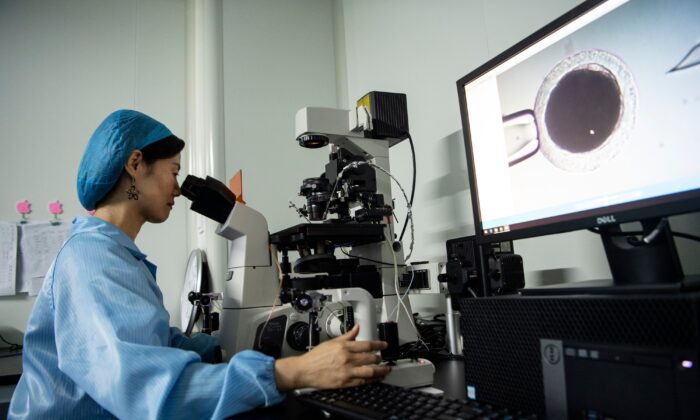WASHINGTON—For 70 years, the United States has been the “undisputed leader in science and technology,” but that’s now changing, according to National Science Board (NSB) member Julia Phillips.
Not only are there more players globally in science and technology (S&T), but the United States has fallen victim to complacency, she said. China likely already exceeds the United States in S&T spending, and based on available data, the crossover point occurred in 2019.
“We must embrace these changes or risk being left behind,” Phillips said during a meeting of the President’s Council of Advisors on Science and Technology (PCAST) and the NSB at the White House on Feb. 4.
U.S. spending in S&T is growing, but global spending is growing much faster, “so our percentage of it is dropping,” she said.
The United States across all sectors spends $548 billion a year on S&T research, but China may be spending up to $200 billion more. In fact, China has accounted for almost one-third of total global growth in S&T research. “They have seized the positive results from our investment” into their country, Phillips said.
However, the United States spends more than any other country on “fundamental” research, a term used by the U.S. scientific community that encompasses both “basic research” and “applied research.” Basic research is done to acquire purely new knowledge, while applied research is directed at not only acquiring new knowledge but also to direct that knowledge to a specific application, such as the creation of a new product.
In 2017, the United States spent $92 billion on basic research alone; China, on the other hand, spent only $27 billion on basic research while focusing its investment into experimental and developmental research, Phillips said. These figures suggest that China’s focus is to take existing and new knowledge developed in other countries and build upon it in practical applications for its own use.
Publishing and Patents
Publishing patterns show that the number of Chinese research papers has risen more than tenfold since 2000, exceeding the United States in “absolute quantity,” Phillips says.
The United States still has a significant lead in terms of most cited research, she said, but even within the U.S. body of published research, 26 percent is in collaboration with Chinese researchers.
Patent activity is another measure of a country’s research and development (R&D) activities. Chinese patent applications to the U.S. Patent Office “grew explosively in the latter part of the 20th century,” according to the NSB.
Among Chinese patents, 63 percent relate to electrical engineering, pointing to China’s focus on developing applications and products for machinery, radar and navigation systems, and communications systems, among others. Today, China has the largest number of international patents, according to the NSB.
Some experts at the event highlighted that China’s R&D spending and patent activity is likely geared toward developing products that can be used not only in civilian but also in military applications. PCAST member Cathy Bessant, chief technology officer at Bank of America, remarked that when it comes to S&T development, the United States needs to “think about defense.”
“When I look at the investment in other countries, I wonder how much of that investment is directed as an attack on us,” she said, adding that “the knowledge of what I defend every day on behalf of us and customers” keeps her up at night.
“How much of their money is going to attack us?”
Different Standards and Systems
From data on China, “we see clearly tremendous investment in building out and owning its own information technology infrastructure,” said Shannon Blunt, a professor of electrical engineering and computer science at the University of Kansas.
China has been running at “a staggering pace and acceleration, and we feel it directly in industry,” he added.
The issue isn’t just in information technology, but also in the policies that China is establishing, he said.
“Through the [“One Belt, One Road”] Initiative, China has 69 countries involved, and they have them developing different standards” from those found in the United States and other Western countries, Blunt said. That means that we now sell into “two different standards and systems.”
The “Digital Silk Road” initiative is a subset of OBOR that supports exporting digital infrastructure to BRI countries throughout Asia, the Middle East, and Africa. Through that infrastructure, China is “using multilateral institutions to establish technological standards related to telecommunications infrastructure and promoting the principle of cybersovereignty at UN forums,” according to a post on Foreign Affairs.
Blunt pointed out that the Chinese regime is forcing companies “to transfer our software and source codes to them” when selling technology into China.
In the venture capital world, Blunt says, the Committee on Foreign Investment in the United States has helped to reduce Chinese investment into the United States, but it “has also pushed it into the shadows.” By the time venture capital is invited into start-ups, “multiple Chinese investments are there already,” he said.
“I suggest that the values upon which we are built are open collaboration and an open approach to science, and that cannot change. That keeps us the strongest,” he said.
“But we have an adversary taking a completely different approach. They are working in a coordinated, collaborative world.”
Blunt recalled former U.S. Defense Secretary Jim Mattis’s comment that we are engaged in an economic cold war. “So when we talk about partnerships, we need to super-size it. Industry, universities, federal laboratories, the National Science Foundation … we have to experiment with a structure where all of these can collaborate in an open manner.”
This article is from the Internet:President’s Science Advisers Warn: China Outpacing the US in Scientific Research
1-Year-Old Baby With Coronavirus Recovers, Is Discharged From Hospital
